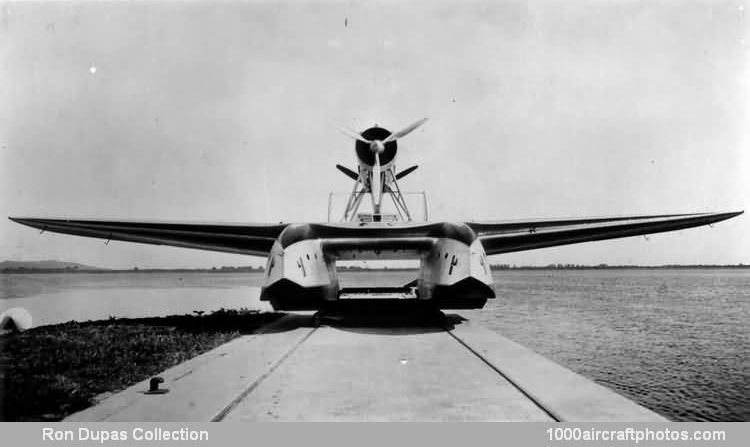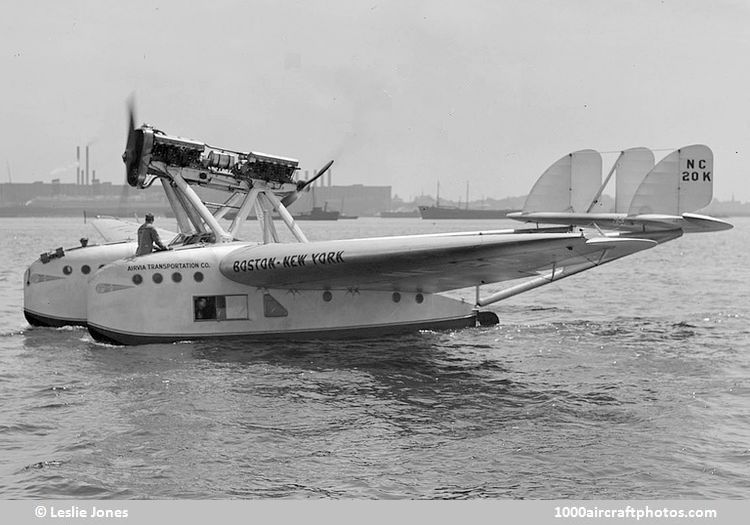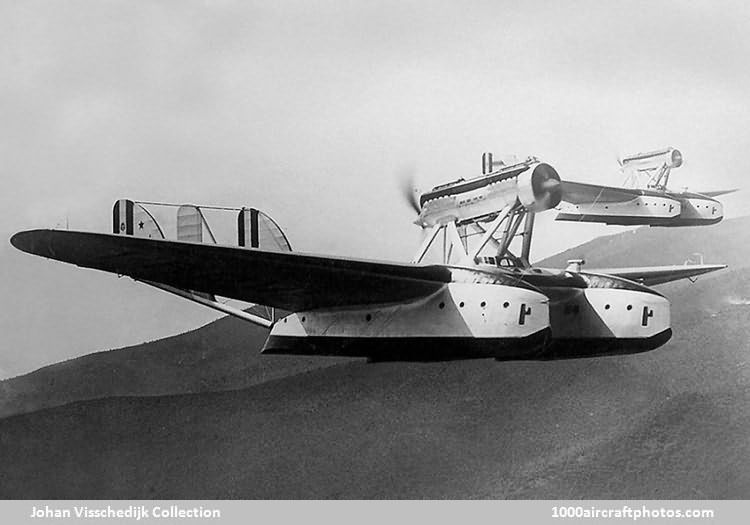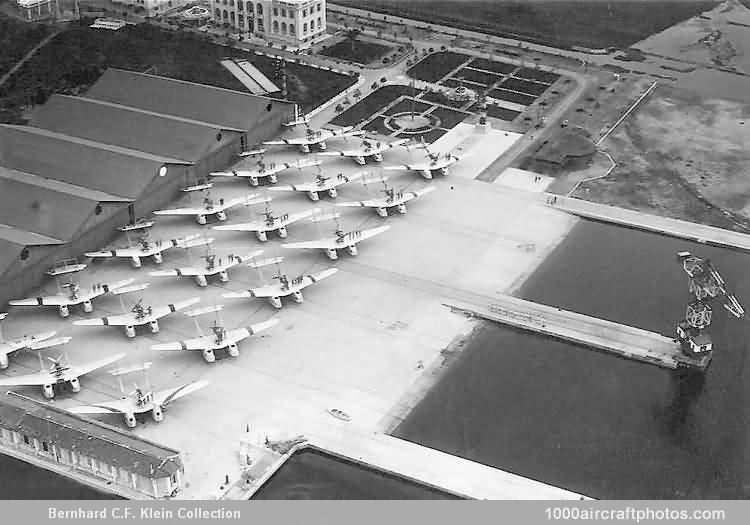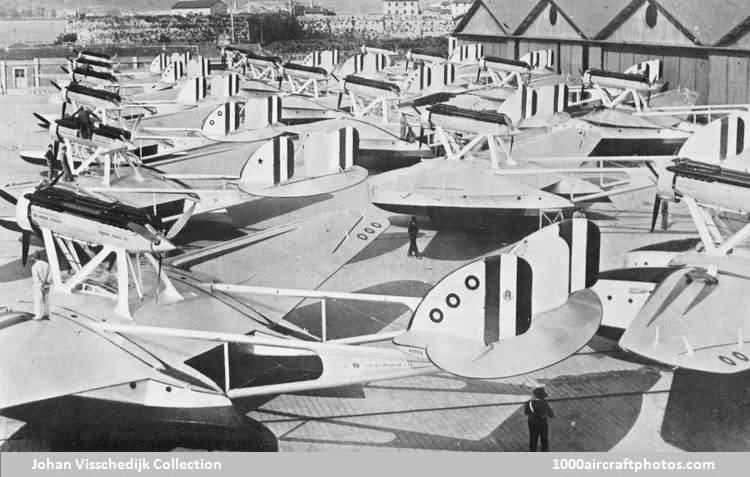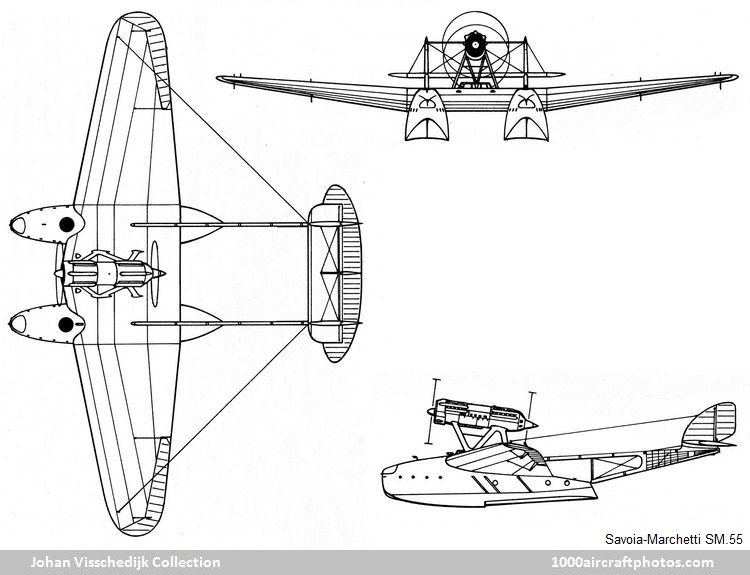02/28/2015. Remarks by
Johan Visschedijk: "One of the most highly-publicized aircraft in the world for its time was the Savoia-Marchetti S.55 twin-engined twin-hull flying boat. Famous for a series of transatlantic flights in an era when any aerial crossing was considered extremely hazardous, the S.55 rightly aroused great public interest. Understanding that most of these flights were made as propaganda demonstrations of the Fascist government does not alter the fact that the design was excellent and the accomplishments exceptional. Projected in 1923 as one of Ing. Marchetti's earliest designs for Savoia-Marchetti, the S.55 was conceived as a torpedo-bomber and mine layer, for which roles the twin-hull arrangement adopted was ideal.
The highly original layout featured two hulls some 14 ft 9 in (4.50 m) between centers, a thick cantilever three-section wing with pilots' cockpit in the leading edge, two engines mounted in tandem on pylons above the wing, driving tractor and pusher two-bladed airscrews, and a vertical tall assembly consisting of two fins and three rudders atop the tail plane, mounted on twin booms extending back from the hulls. The extremely sea-worthy structure was plywood-covered spruce, ash, and plywood throughout, with fabric covered control surfaces. Hydrodynamic characteristics were excellent; in addition to the ruggedness and stability in heavy seas, the S.55 was considered to be extremely graceful (for a six-ton machine!) when arising from or alighting on the water.
The original military S.55M of 1925, with two 400 hp Lorraine-Dietrich engines, featured observers' cockpits in the rear of each hull with Scarff ring mountings for 0.303 in (7.7 mm) machine guns. Torpedoes, bombs, or mines could be carried below the center section of the wing. Nose gun positions were added later.
Savoia-Marchetti S.55P (NC20K) (
Leslie Jones Collection)
In addition to the military model, ten to twelve-passenger (five-six in each hull) commercial models, the S.55C and S.55P, were built for Aero Espressa Italiana for the Brindisi-Constantinople line, and for the SocietÓ Aerea Mediterranea for the Rome-Cagliari run.
In 1926 two 500 hp Isotta-Fraschini Asso twelve-cylinder V-engines replaced the Lorraines. The same year the S.55 captured fourteen world records for speed, altitude, load, and distance. With the same model, Col. Il Marchese de Pinedo made the first of the S.55's many famous flights. In 1927, de Pinedo's flying boat, dubbed the Santa Maria, made a 28,000 mls (45,062 km) flight around the Atlantic, starting from Elmas, Sardinia, on February 13. De Pinedo was on one stage towed 200 mls (322 km) over the water to the Azores on his way back to Italy. In North America he landed on numerous lakes and rivers; on an artificial lake near Phoenix, Arizona, a carelessly discarded cigarette accidentally set fire to the plane and destroyed it.
A second machine, the Santa Maria IIa , was sent by ship from Italy. With the replacement de Pinedo flew to the Eastern US and Canada, and finally back to Italy by way of the Azores and Lisbon, Portugal, completing the journey on June 16. Demonstrating the strength and dependability of the S.55, de Pinedo's flight was a great boost for the possibilities of transatlantic commercial service, despite the fact that the Santa Maria was a military model. The following year the S.55 of the Brazilians De Barros and Braga completed a more direct flight from Italy to their homeland.
The improved S.55A, with two 700 hp FIAT A.24R twelve-cylinder V-type or 800 hp Isotta-Fraschini Asso eighteen-cylinder W-type engines, appeared in 1930. Twelve S.55As made a 6,500 mls (10,460 km) mass flight from Ortobello (Rome) to Rio de Janeiro in 1930, led by Air Marshall Italo Balbo.
Savoia-Marchetti S.55X) (
Johan Visschedijk Collection)
This flight was overshadowed three years later by the North Atlantic crossing of 24 machines (with a 25th as reserve) on the occasion of the Chicago World's Fair. An aerodynamically-refined model, the S.55X, powered by 750 hp Isotta-Fraschini Asso engines, was employed. Changes included much smoother hulls and engine cowlings, fairings at the joining of all major components, and three-bladed metal airscrews with spinners.
One S.55X crashed at Amsterdam on the outward journey and another at the Azores on the return flight, but 24 machines made a triumphant arrival at Chicago and New York. The 6,065 mls (9,761 km) outward trip (Ortobello-Chicago) was made in 48 hrs 47 min flying time, for an average of 124.6 mph (200.5 kmh). Total distance was 11,495 mls (18,500 km). Four squadrons (Nera, Rossa, Bianca, Verde = Black, Red, White, and Green) of six machines each were led respectively by Gen. Balbo (civil registration appropriately I-BALB), Captain Nannini (I-NANN), Captain Giordano (I-GIOR), and Captain Biani (I-BIAN). The registrations of the remaining 20 aircraft also indicated their captains.
Savoia-Marchetti S.55X) (
Johan Visschedijk Collection)
After returning back at their home base at Orbetello, Italy, eighteen S.55Xs were pictured with some of the crews standing on the wings. This flight, more than any other single accomplishment, gave Italy her great prestige in the field of aviation during the 1930s, and was of inestimable political value.
A less well-known flight of the S.55 was that of Demcenko and Koukin from Sesto Calende to Petropavlovsk, approximately 14,000 mls (22,500 km) across Siberia, in 1932. Besides the more spectacular long-distance flights, the S.55 had a long career with the Italian Navy, serving for more than ten years. Although thirteen machines were listed as available in 1939, the S.55 had by that time reached the end of its service life, and was withdrawn. No machines of the type saw wartime service. The SM.60 was a landplane bomber version which was never built."
